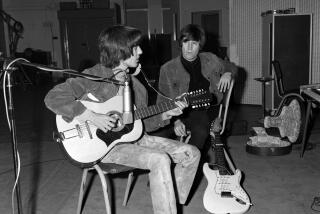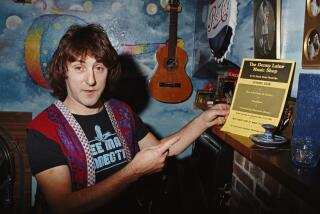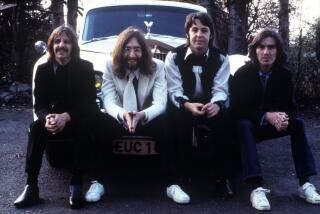‘Live Peace’ Offers a Rare Look at Post-Beatles Lennon
*** The Plastic Ono Band, “Live Peace in Toronto 1969,” Capitol. “OK, we’re just going to do numbers that we know . . . because we’ve never played together before,” John Lennon says at the start of this September, 1969, stadium concert with a band that featured Lennon on vocals and guitar, Yoko Ono on vocals, Eric Clapton on guitar, Klaus Voorman on bass and Alan White on drums.
Though it was the first major concert appearance by a Beatles member since the group quit touring in 1966, the live album didn’t seem all that significant when released the following January. Reviews were modest and it only reached No. 10 on the U.S. charts. The reason is that the Beatles’ “Abbey Road,” which was released in October of 1969, got all the commercial and critical attention.
“Live Peace,” which is available for the first time on CD, is more prized today than it was then because it documents one of the few post-Beatles times that Lennon stepped on stage. In the 40-minute set, Lennon celebrates his own rock roots (“Money,” “Blue Suede Shoes” and “Dizzy Miss Lizzy”) and some of his Beatles work (“Yer Blues”).
In addition, the set contains “Cold Turkey” (a studio version of which was later released as a single), “Give Peace a Chance” (which had been a Top 20 single that fall) and two Ono-led art-rock excursions.
While there is a tentativeness to the playing that strips the music of some of its fire, Lennon’s voice reflects his customary passion, and it’s endearing to hear him employ that passion with equal conviction on his old favorites and on his own, more substantial compositions.
* 1/2 Ringo Starr, “Beaucoups of Blues,” Capitol. Just as Lennon touched on his rock roots in the Toronto concert, Ringo celebrates his fondness for country music in this solo outing, which was recorded in Nashville in 1970 and features some of the town’s most accomplished musicians, including Pete Drake, who also produced the collection. The problem is the mediocre material. Rather than allow himself the luxury of choosing from the great storehouse of country hits, Ringo opted for new material. It was a daring move, but the choices were too bland.
** Floyd Cramer, “The Essential Floyd Cramer,” RCA. Though he didn’t play on Ringo’s album, Cramer was the premier country pianist for decades, appearing on so many classic hits that he was widely hailed as one of the architects of the Nashville sound. His trademark was a way of bending the piano notes that gave them a sound both evocative and distinctive. Ultimately, Cramer’s approach became something of a cliche in Nashville, and his solo recordings haven’t worn well. You’d get a better idea of Cramer’s contributions and talent from an album that featured both some of the classic hits that Cramer played on (from Elvis Presley’s “Heartbreak Hotel” to Don Gibson’s “O Lonesome Me”) and some solo tracks (including “Last Date,” “On the Rebound” and “I’m So Lonesome I Could Cry”).
** 1/2 Tim Hardin, “Live in Concert,” Polydor. Hardin was one of the most gifted folk-accented singer-songwriters of the modern pop era, and he sang his own restless tales of love and longing (including “If I Were a Carpenter” and “Reason to Believe”) with some of the soulfulness of Hank Williams and Ray Charles. He wasn’t captured at his best in this 1968 performance, but the album earns a place in rock history because it is the late singer’s only live package.
Albums are rated on a scale of one star (poor), two stars (fair), three stars (good) and four stars (e x cellent).
More to Read
The biggest entertainment stories
Get our big stories about Hollywood, film, television, music, arts, culture and more right in your inbox as soon as they publish.
You may occasionally receive promotional content from the Los Angeles Times.










